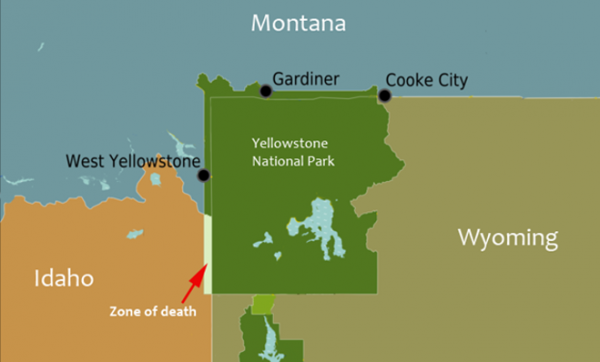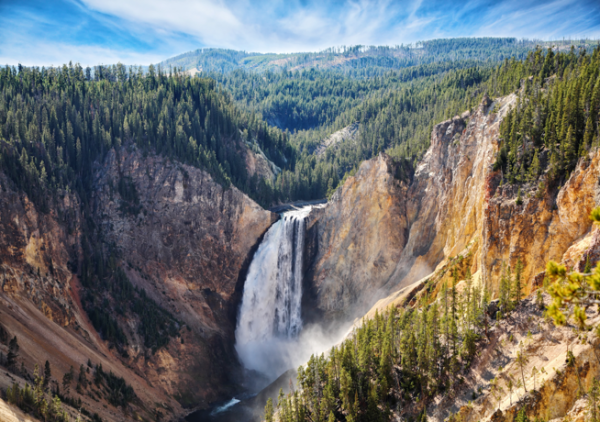Is Yellowstone National Park a magnet for murder? Whether through the power of the internet or DNA testing, law enforcement officials use sophisticated technologies that make it harder for criminals to escape justice. However, even the most sophisticated technological tools are useless when it is not clear who is able to try a criminal, creating loopholes that risk allowing crimes to go unpunished. Public lands are prone to these kinds of ambiguities because they are jurisdictionally complicated places. They can be a patchwork of local, state, tribal, private, or federal land. They can even lie across state or national borders.

Determining who is in charge can be difficult. This is the case for a specific location in Yellowstone National Park. Due to a loophole embedded in the Constitution, if a crime occurred in a specific area of the park the criminal technically could not be tried. This place is aptly named “The Yellowstone Zone of Death.” The actual likelihood of getting away with murder in a national park is small. However, the Yellowstone Death Zone symbolizes just how deeply rooted in history present-day public lands issues can be.
Why the Yellowstone Zone of Death Exists
The constitutional loophole that created the Yellowstone Death Zone is embedded in a section of legal language in the Sixth Amendment called the Vicinage Clause. It states that a trial shall be formed “by an impartial jury of the State and district wherein the crime shall have been committed, which district shall have been previously ascertained by law.”[1] In plain language, this gives a person charged with a crime the right to have a jury summoned from the state and district where the crime was committed, or, from the same vicinity.[2]
The reason why the death zone exists lies in the park’s history. Yellowstone was established as the world’s first national park in 1872, before Idaho, Wyoming, and Montana became states.[3] Although most of Yellowstone lies within Wyoming, about nine percent of the park extends into Montana (260 square miles) and Idaho (50 square miles).[4] When the states were admitted in 1889 and 1890, each gave exclusive jurisdiction of their portion of the park to the federal government. Later, when Congress was establishing the United States District Court for the District of Wyoming, it placed Yellowstone fully within the District of Wyoming, making it the only district that lies in multiple states.[5]
As a result of the Vicinage Clause, all crimes committed in the District of Wyoming must summon a jury from the District of Wyoming. Yet at the same time, all crimes committed in Idaho or Montana require a jury from Idaho or Montana, respectively. According to the Sixth Amendment, it is the accused’s right to have the jury summoned from the District of Wyoming and Idaho.[6] The solution may seem simple. The jury should be summoned from the Idaho portion of Yellowstone park—where the district of Wyoming and Idaho overlap. The only problem is, according to the 2000 Census, this area has a population of exactly zero (the Montana portion has a small population).[7]

What’s at Stake in Yellowstone?
With a loophole in the document that represents the very foundation of American government, it would seem that something would be done to eradicate this issue. Yet, nothing has been done. Brian C. Kalt, the author of “The Perfect Crime”—the first article to address the Zone of Death—published another article that discusses his attempts to lobby for closing the Vicinage Clause’s loophole in Yellowstone. Throughout the article, Kalt describes his attempts and failures to get Congress to change the law. Kalt eventually contacted senator Mike Simpson of Idaho. However, the senator believed the judicial system would “prevail” in such a situation and there would be no plans for redistricting.[8] So, the Yellowstone Death Zone continued to exist.
The actual danger posed by the Zone of Death is likely minimal, but the area has fired filmmakers’ and authors’ imaginations as they contemplate the possibilities. In 2016, Julien Pinder and Adam Levins directed Population Zero, a film that tells the story of a fictional triple murder in the Zone of Death in which the murderer walks free. Other works, such as the novel Free Fire, show how the Zone of Death could pose a serious threat to the American justice system. Although these are just fictional stories, they raise concerns about how a real crime in the Zone of Death would be dealt with.
The Solution
Eliminating the Zone of Death should be simple; redrawing the District of Wyoming would solve the problem. However, Redistricting is currently a controversial topic due to gerrymandering—partisan drawing of districts. Due to the unlikelihood of a serious crime occurring in the national park, most people are not concerned with the Zone of Death. Yet, because the issue is so deeply embedded within the Constitution, the remotest possibility of a case that would weigh the text of America’s founding document against its intent to maintain rule of law is something that should demand attention from lawmakers in its own right. In some ways, it is almost poetic that the most American document may be tested in one of the nation’s most American places.
-Thomas Dunnington, High School Student Contributor and Ariel Schnee, Program Manager, Public Lands History Center
Published 03/05/2020
Sources
[1] “Sixth Amendment,” Legal Information Institute, last modified October 10, 2017, https://www.law.cornell.edu/constitution/sixth_amendment.
[2] William Wirt Blume, “The Place of Trial of Criminal Cases: Constitutional Vicinage and Venue.” Michigan Law Review 43, no. 1 (1944): 59-94, https://www.jstor.org/stable/1283976.
[3] “History & Culture,” National Parks Service, last modified March 27, 2019, https://www.nps.gov/yell/learn/historyculture/index.htm.
[4] Brian C. Kalt, “The Perfect Crime,” Georgetown Law Journal, Vol. 93, no. 2 (2005): 675-688, SSRN.
[5] Kalt, “The Perfect Crime,” 678.
[6] Legal Information Institute, “Sixth Amendment.”
[7] Kalt, “The Perfect Crime,” 678.
[8] Brian C. Kalt, “Tabloid Constitutionalism: How a Bill Doesn’t Become a Law,” Georgetown Law Journal, Vol. 96, no. 6 (2008): 1971-1984, SSRN.